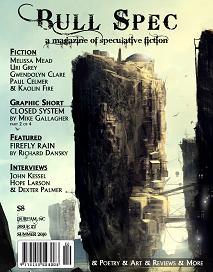Bull Spec #2
Summer 2010
“Echoes of a Bouncing Ball” by Paul Celmer
“By the Dragon’s Tail” by Kaolin Fire
“Hirasol” by Melissa Mead
“The Other Lila” by Gwendolyn Clare
“The Sad Tale of the Naga” by Uri Grey
Reviewed by Rena Hawkins
In his story “Echoes of the Bouncing Ball,” Paul Celmer introduces us to Richard Wheeler, a traveling salesman in space. When Wheeler purchases a toy on a distant world for his son, he doesn’t realize the toy will give him the ability to change the path of his life.
Although “Echoes of the Bouncing Ball” is constructed as science fiction, science, space, and aliens aren’t needed to tell the story. If Richard Wheeler traveled on a sailing ship instead of a space ship, if he purchased the toy in a distant land from a wizard instead of on a distant world from an alien, and if the ball took him back in time due to magic instead of technology, would the story really be any different? The story’s biggest weakness is that it could easily be rewritten as fantasy or urban magic.
In “By the Dragon’s Tail” by Kaolin Fire, Kithshar, injured in a mining accident, consults a Teller to see what his future will bring. When the Teller predicts Kith will go on a quest to seek the dragon’s tail, Kith is angry and doesn’t believe him. Yet, Kith immediately climbs up the city’s volcano to seek the dragons. Within sentences, Kith is grabbing at dragons as they burst out of the volcano. When his hand is caught on a dragon’s scale, Kith must literally hold on for dear life.
I’m afraid this fantasy story doesn’t work for me. The story feels rushed and although I read through it multiple times (which isn’t difficult since it’s so short) I never understood the story’s setting or how Kith, a miner, knew anything about dragons to begin with. Diehard dragon fans will probably be entertained.
“Hirasol” by Melissa Mead is the story of Dr. Sanchez and her assistant, Branson, who have come to a distant world seeking a cure for a pandemic on Earth. The planet is inhabited by the Herd, a group of beings who are part horse and part humanoid like earth’s mythical centaurs. When Dr. Sanchez and Branson find a young member of the Herd who has broken his front legs, Dr. Sanchez has to perform a drastic operation on him in order to save his life. The young centaur, who Dr. Sanchez names Hirasol, struggles to accept a new life very different from the one he was born to lead.
Mead makes the young centaur Hirasol very sympathetic while conveying to us that he’s an alien and doesn’t view his situation the way a human might. Some hard science fiction fans may find the story too sweet, but I enjoyed it very much.
As we all learned from Star Trek, transporters are a bitch. In “The Other Lila” by Gwendolyn Clare, that great tradition continues. An “error” has occurred when Lila makes a routine teleport–there’s now an identical copy of her and neither Lila is very happy about it. How will they share identities? Finances? Apartments? Their girlfriend, Abby?
“The Other Lila” is a wonderful example of how to make every sentence count in a very short story. My favorite of the issue.
Told in the first person, “The Sad Tale of the Naga” by Uri Grey is the story of a young man who picks up a hitchhiking naga. On the ride, she tells him the sad tale of her fall from being a goddess as monotheism spreads throughout the world. It’s difficult to make a story with a religious theme entertaining and engaging, but Grey does a nice job.
Overall, I’m impressed with Bull Spec. For those who don’t know, Bull Spec is based in Durham, North Carolina, home of the Durham Bulls baseball team and often referred to as “Bull City.” The production quality is very high. The magazine, a full 8.5″ x 11”, has a great, heavy feel, and the cover art for this issue (by Vladimir Krizan) is gorgeous. Inside, there’s also a graphic short, book reviews, poetry, and an interview with John Kessel. My hope is that Bull Spec increases the space allotted to fiction and offers more complex stories of longer length.